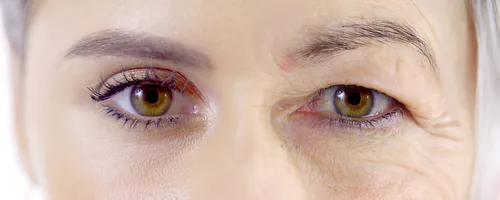The aging process significantly affects the eyes and the surrounding areas, leading to various changes that can alter one’s appearance and vision. These changes are due to the interplay of factors involving the skin, muscles, fat, and bone around the eyes.
1. Changes in Eyelids and Skin
As we age, the skin around the eyes becomes thinner and loses elasticity. The upper eyelids tend to droop due to the elongation of the upper lid length and the loss of alignment between the upper eyelid fold and the upper lid margin. This descent is primarily caused by age-related levator dehiscence, where the tendon of the levator muscle of the eyelid loosens or detaches. Additionally, the loss of elasticity and deflation of the upper eyelid subcutaneous tissue contribute to this drooping effect.
2. Fat Redistribution and Volume Loss
Facial fat, particularly around the eyes, undergoes significant changes with age. The upper and lower eyelids experience a loss of volume due to the atrophy of periorbital fat. This loss of fat can cause the upper eyelid arc to change, often resulting in a more sunken appearance. In the lower eyelids, fat herniation leads to the formation of under-eye bags, as the inferior orbital rim recedes and the soft tissues lose their structural support.
3. Bone Remodeling
Aging affects the bones around the eyes, particularly the orbital rim. The orbital aperture increases in width and area as the superior orbital rim height increases medially and the inferior orbital rim recedes laterally. This recession causes the eyes to appear smaller and more deep-set, contributing to a more tired and aged appearance.
4. Muscle and Ligament Changes
The muscles around the eyes also undergo changes. The orbicularis oculi muscle, responsible for closing the eyelids, can lead to the formation of crow’s feet lines due to repetitive contraction. These lines become more pronounced as the overlying skin thins and loses fat. Additionally, the stretching of the suspensory ligament of the eye contributes to changes in the eye’s position within the orbit, leading to conditions like senile enophthalmos, where the eye appears sunken.
5. Tear Troughs and Under-Eye Bags
The tear trough, the hollow between the eye area and the upper medial cheek, becomes more prominent with age. This is due to the deflation of soft tissue, fat atrophy, and fat descent. The muscular and bony anatomy of the tear trough is unmasked as the deep periorbital fat atrophies, leading to a concave and indented appearance. The severity of tear troughs increases with the loss of midface volume, exacerbating the aged appearance of the eyes.
The aging process around the eyes involves a complex interplay of changes in the skin, fat, muscle, and bone. These changes contribute to the characteristic signs of aging, such as drooping eyelids, under-eye bags, and hollow tear troughs. Understanding these changes can help doctor in developing effective strategies for addressing the signs of aging and maintaining a youthful appearance around the eyes.

